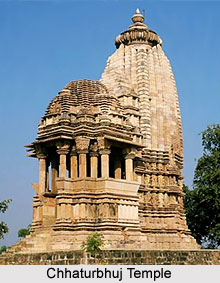 Chhaturbhuj Temple is also known as Jatakari Temple due to its location. The temple is located near a village Jatakara at Khajuraho. Chaturbhuj is a derived from Sanskrit which literally means one who has four arms; and refers to Lord Vishnu. This is the only temple which lacks erotic sculptures. Temple consists of a sanctum without ambulatory, vestibule, mandapa and an entrance porch. The temple stands on a modest or chabutara. There are three bands of sculptures around the wall. It has the images of dikhpalas, ashtavasus, nymphs and mythical lions. Shikhara, sanctum, mahamandapa and ardhamandapa are interconnected located on the same axis.
Chhaturbhuj Temple is also known as Jatakari Temple due to its location. The temple is located near a village Jatakara at Khajuraho. Chaturbhuj is a derived from Sanskrit which literally means one who has four arms; and refers to Lord Vishnu. This is the only temple which lacks erotic sculptures. Temple consists of a sanctum without ambulatory, vestibule, mandapa and an entrance porch. The temple stands on a modest or chabutara. There are three bands of sculptures around the wall. It has the images of dikhpalas, ashtavasus, nymphs and mythical lions. Shikhara, sanctum, mahamandapa and ardhamandapa are interconnected located on the same axis.
The main idol in the temple is of four-armed Lord Vishnu. The lintel of the doorway has carved figures of Brahma, Vishnu and Shiva. The temple stands lonely and serene on a high platform against the backdrop off the Lavanya hills. This is the only temple in Khajuraho that faces west. The temple is similar to Javari of the eastern group of temples. It has a shallow porch, a little mandap surmounted by a peaked roof and a small square garbha griha above which rises a tall, slim shikhara. The outer walls of the temple are organized into three bands of sculpture and there are a number of unusual niche figures which include the consort of Narasimha on the north side. The tower is simple.
The temple has an ornamental doorway and the enormous image within the sanctum. The image of main deity is carved out of a single stone. There is a Sura Sundari("Beauty of the Gods") sculpture. Sura Sundaris are depicted attending important Gods. Here they are shown depicting Vishnu in this case.
The temple came into existence in the 15th century. As per historical evidences Chaturbhuj temple was built by Maharani Ganesh Kunwar, Madhukar`s wife and was meant for Lord Rama, who refused to move from his place in Ayodhya. The ruler of Orchha, Madhukar Shah, then placed an idol of Chatturbhuj (four-armed) Lord Vishnu in the spacious temple after it was constructed.





















